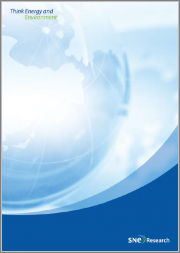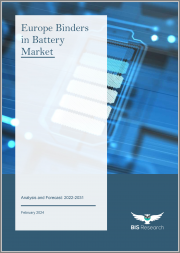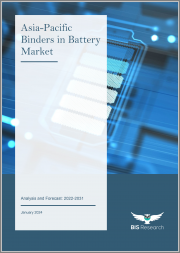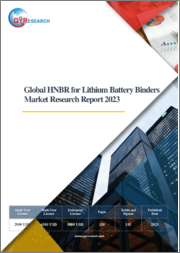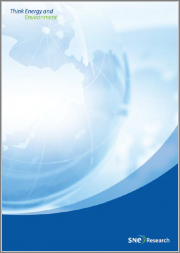
|
시장보고서
상품코드
1577631
리튬배터리 양극 바인더 시장 : 배터리 유형, 소재 유형, 용도별 - 세계 예측(2025-2030년)Lithium Battery Positive Electrode Binders Market by Battery Type, Material Type, Application - Global Forecast 2025-2030 |
||||||
2023년 리튬배터리 양극 바인더 시장 규모는 36억 8,000만 달러로 2024년에는 40억 7,000만 달러에 달할 것으로 예상되며, CAGR 10.21%로 성장하여 2030년에는 72억 8,000만 달러에 달할 것으로 예상됩니다.
리튬배터리 양극 바인더 시장은 리튬이온 배터리에 사용되는 활성 입자를 연결하고 사이클 동안 구조적 무결성을 유지하기 위해 사용되는 재료에 초점을 맞추고 있습니다. 이러한 바인더는 배터리의 효율, 수명 및 안전성을 보장하는 데 매우 중요합니다. 양극 바인더의 필요성은 전기자동차(EV), 가전제품, 에너지 저장 시스템 등 배터리 응용 분야가 급속히 확대되고 있기 때문입니다. 가볍고 에너지 밀도가 높은 배터리에 대한 수요가 증가함에 따라, 기계적 및 열적 스트레스를 견디면서 배터리 성능을 향상시킬 수 있는 고급 바인더에 대한 필요성도 증가하고 있습니다. 이 시장의 최종 용도에는 주로 자동차 제조업체, 전자 기업, 재생에너지 공급업체가 포함되며, 이들 모두 제품 및 솔루션에 고성능 배터리를 필요로 합니다.
| 주요 시장 통계 | |
|---|---|
| 기준 연도[2023] | 36억 8,000만 달러 |
| 예측 연도[2024] | 40억 7,000만 달러 |
| 예측 연도[2030] | 72억 8,000만 달러 |
| CAGR(%) | 10.21% |
시장의 주요 성장 촉진요인으로는 전기자동차 보급 확대, 재생에너지 저장 솔루션의 발전, 소비자 전자제품의 지속적인 발전 등이 있습니다. 배터리 효율과 수명주기를 개선하는 혁신적인 바인더 배합에 대한 연구 투자 증가는 새로운 기회를 창출하고 있습니다. 유해한 배출을 줄이는 수성 바인더와 같은 친환경적이고 비용 효율적인 바인더 솔루션에 투자하는 기업은 경쟁 우위를 점할 수 있습니다. 그러나 높은 생산 비용, 재료의 가용성, 엄격한 산업 규제 등의 문제가 시장 성장에 걸림돌이 될 수 있습니다. 이를 해결하기 위해서는 연구 기관과의 협력과 지속가능한 기술 개발을 위한 정부 지원의 활용이 필수적입니다.
혁신의 기회는 배터리의 재활용성과 환경 영향을 개선하는 생체적합성 및 지속가능한 바인더를 개발하는 데 있습니다. 새로운 바인더 솔루션을 만들기 위한 나노기술과 첨단 소재에 대한 탐구는 성능을 획기적으로 향상시킬 수 있습니다. 시장은 매우 역동적이며, 기술 발전과 환경 친화적인 솔루션을 요구하는 규제 프레임워크에 힘입어 매우 역동적입니다. 솔리드 스테이트 배터리 및 성능 최적화를 위한 AI 통합과 같은 새로운 트렌드에 대한 지속적인 적응과 선견지명은 중요한 이점을 제공합니다. 전략적 파트너십과 R&D 투자에 집중하는 기업은 민첩성을 유지하고, 변화하는 시장 환경 속에서 성장 기회를 포착할 수 있습니다.
시장 역학 : 빠르게 진화하는 리튬배터리 양극 바인더 시장의 주요 시장 인사이트 공개
리튬배터리 양극 바인더 시장은 수요와 공급의 역동적인 상호작용에 의해 변화하고 있습니다. 이러한 시장 역학의 변화를 이해함으로써 기업은 정보에 입각한 투자 결정을 내리고, 전략적 의사결정을 정교화하며, 새로운 비즈니스 기회를 포착할 수 있습니다. 이러한 트렌드를 종합적으로 파악함으로써 기업은 정치적, 지리적, 기술적, 사회적, 경제적 영역 전반에 걸친 다양한 리스크를 줄일 수 있으며, 소비자 행동과 그것이 제조 비용 및 구매 동향에 미치는 영향을 보다 명확하게 이해할 수 있습니다.
Porter's Five Forces : 리튬배터리 양극 바인더 시장을 탐색하는 전략적 도구
Porter's Five Forces 프레임워크는 시장 상황의 경쟁 상황을 이해하는 중요한 도구입니다. Porter's Five Forces 프레임워크는 기업의 경쟁력을 평가하고 전략적 기회를 탐색할 수 있는 명확한 방법을 제공합니다. 이 프레임워크는 기업이 시장 내 세력도를 평가하고 신규 사업의 수익성을 판단하는 데 도움이 됩니다. 이러한 인사이트를 통해 기업은 강점을 활용하고, 약점을 해결하고, 잠재적인 도전을 피하고, 보다 강력한 시장 포지셔닝을 확보할 수 있습니다.
PESTLE 분석 : 리튬배터리 양극 바인더 시장의 외부 영향 파악
외부 거시 환경 요인은 리튬배터리 양극 바인더 시장의 성과 역학을 형성하는 데 매우 중요한 역할을 합니다. 정치적, 경제적, 사회적, 기술적, 법적, 환경적 요인에 대한 분석은 이러한 영향을 탐색하는 데 필요한 정보를 제공하며, PESTLE 요인을 조사함으로써 기업은 잠재적 위험과 기회를 더 잘 이해할 수 있습니다. 이러한 분석을 통해 기업은 규제, 소비자 선호도, 경제 동향의 변화를 예측하고 선제적이고 능동적인 의사결정을 내릴 준비를 할 수 있습니다.
시장 점유율 분석 : 리튬배터리 양극 바인더 시장 경쟁 상황 파악
리튬배터리 양극 바인더 시장의 상세한 시장 점유율 분석을 통해 벤더의 성과를 종합적으로 평가할 수 있습니다. 기업은 수익, 고객 기반, 성장률과 같은 주요 지표를 비교하여 경쟁적 위치를 파악할 수 있습니다. 이 분석은 시장의 집중화, 단편화, 통합의 추세를 파악할 수 있으며, 공급업체는 치열한 경쟁 속에서 자신의 입지를 강화할 수 있는 전략적 의사결정을 내리는 데 필요한 인사이트를 얻을 수 있습니다.
FPNV 포지셔닝 매트릭스 : 리튬배터리 양극 바인더 시장에서의 공급업체 성과 평가
FPNV 포지셔닝 매트릭스는 리튬배터리 양극 바인더 시장에서 공급업체를 평가하는 중요한 도구입니다. 이 매트릭스를 통해 비즈니스 조직은 벤더의 비즈니스 전략과 제품 만족도를 기반으로 평가하여 목표에 부합하는 정보에 입각한 의사결정을 내릴 수 있으며, 4개의 사분면으로 벤더를 명확하고 정확하게 세분화하여 전략적 목표에 가장 적합한 파트너와 솔루션을 식별할 수 있습니다. 전략 목표에 가장 적합한 파트너와 솔루션을 식별할 수 있습니다.
전략 분석 및 추천 : 리튬배터리 양극 바인더 시장에서 성공의 길 찾기
리튬배터리 양극 바인더 시장의 전략적 분석은 세계 시장에서 입지를 강화하고자 하는 기업에게 필수적입니다. 주요 자원, 역량 및 성과 지표를 검토함으로써 기업은 성장 기회를 식별하고 개선할 수 있습니다. 이러한 접근 방식을 통해 경쟁 환경의 도전을 극복하고 새로운 비즈니스 기회를 활용하여 장기적인 성공을 거둘 수 있도록 준비할 수 있습니다.
이 보고서는 주요 관심 분야를 포괄하는 시장에 대한 종합적인 분석을 제공합니다.
1. 시장 침투도 : 현재 시장 환경의 상세한 검토, 주요 기업의 광범위한 데이터, 시장 도달 범위 및 전반적인 영향력을 평가합니다.
2. 시장 개척도 : 신흥 시장에서의 성장 기회를 파악하고, 기존 분야의 확장 가능성을 평가하며, 미래 성장을 위한 전략적 로드맵을 제공합니다.
3. 시장 다각화 : 최근 제품 출시, 미개척 지역, 업계의 주요 발전, 시장을 형성하는 전략적 투자를 분석합니다.
4. 경쟁 평가 및 정보 : 경쟁 상황을 철저히 분석하여 시장 점유율, 사업 전략, 제품 포트폴리오, 인증, 규제 당국의 승인, 특허 동향, 주요 기업의 기술 발전 등을 검토합니다.
5. 제품 개발 및 혁신 : 향후 시장 성장을 촉진할 것으로 예상되는 첨단 기술, 연구 개발 활동 및 제품 혁신을 강조합니다.
이해관계자들이 충분한 정보를 바탕으로 의사결정을 내릴 수 있도록 다음과 같은 중요한 질문에 대한 답변도 제공합니다.
1. 현재 시장 규모와 향후 성장 전망은?
2. 최고의 투자 기회를 제공하는 제품, 부문, 지역은 어디인가?
3. 시장을 형성하는 주요 기술 동향과 규제의 영향은?
4. 주요 벤더의 시장 점유율과 경쟁 포지션은?
5. 벤더의 시장 진입 및 철수 전략의 원동력이 되는 수익원과 전략적 기회는 무엇인가?
목차
제1장 서문
제2장 조사 방법
제3장 주요 요약
제4장 시장 개요
제5장 시장 인사이트
- 시장 역학
- 성장 촉진요인
- 성장 억제요인
- 기회
- 과제
- 시장 세분화 분석
- Porter's Five Forces 분석
- PESTEL 분석
- 정치
- 경제
- 사회
- 기술
- 법률
- 환경
제6장 리튬배터리 양극 바인더 시장 : 배터리 유형별
- 인산철리튬
- 나노기술 강화
- 표준
- 망간산리튬
- 레이어드
- 스피넬
- 리튬 니켈 코발트 알루미늄 산화물
- 리튬 니켈 망간 코발트 산화물
- 고전압
- 표준
- 티탄산 리튬
제7장 리튬배터리 양극 바인더 시장 : 소재 유형별
- 카복시메틸셀룰로오스
- 폴리아크릴산
- 개질
- 표준
- 폴리비닐리덴플루오라이드
- 공중합체
- 호모폴리머
- 스티렌 부타디엔 고무
- 고분자량
- 저분자량
제8장 리튬배터리 양극 바인더 시장 : 용도별
- 자동차
- 전기자동차
- 상용차
- 승용차
- 하이브리드 전기자동차
- 전기자동차
- 가전
- 노트북
- 스마트폰
- 태블릿
- 웨어러블
- 에너지 저장 시스템
- 상업용
- 주거용
- 유틸리티 스케일
- 산업
- 의료기기
- 전동 공구
- 통신
제9장 아메리카의 리튬배터리 양극 바인더 시장
- 아르헨티나
- 브라질
- 캐나다
- 멕시코
- 미국
제10장 아시아태평양의 리튬배터리 양극 바인더 시장
- 호주
- 중국
- 인도
- 인도네시아
- 일본
- 말레이시아
- 필리핀
- 싱가포르
- 한국
- 대만
- 태국
- 베트남
제11장 유럽, 중동 및 아프리카의 리튬배터리 양극 바인더 시장
- 덴마크
- 이집트
- 핀란드
- 프랑스
- 독일
- 이스라엘
- 이탈리아
- 네덜란드
- 나이지리아
- 노르웨이
- 폴란드
- 카타르
- 러시아
- 사우디아라비아
- 남아프리카공화국
- 스페인
- 스웨덴
- 스위스
- 터키
- 아랍에미리트
- 영국
제12장 경쟁 상황
- 시장 점유율 분석, 2023년
- FPNV 포지셔닝 매트릭스, 2023년
- 경쟁 시나리오 분석
- 전략 분석과 제안
기업 리스트
- 1. Advanced Lithium Electrochemistry Co., Ltd.
- 2. Arkema
- 3. Asahi Kasei Corporation
- 4. Ashland Global Holdings Inc.
- 5. BASF SE
- 6. Dow Chemical Company
- 7. Henkel AG & Co. KGaA
- 8. Hitachi Chemical Co., Ltd.
- 9. Kraton Corporation
- 10. Kureha Corporation
- 11. LG Chem
- 12. Nippon Shokubai Co., Ltd.
- 13. Shin-Etsu Chemical Co., Ltd.
- 14. Solvay
- 15. Sumitomo Chemical Co., Ltd.
- 16. Targray
- 17. Zeon Corporation
The Lithium Battery Positive Electrode Binders Market was valued at USD 3.68 billion in 2023, expected to reach USD 4.07 billion in 2024, and is projected to grow at a CAGR of 10.21%, to USD 7.28 billion by 2030.
The lithium battery positive electrode binder market focuses on materials used in lithium-ion batteries to connect active particles and maintain structural integrity during cycling. These binders are crucial in ensuring battery efficiency, longevity, and safety. The necessity of positive electrode binders stems from the rapid expansion of battery applications across electric vehicles (EVs), consumer electronics, and energy storage systems. As the demand for lightweight, high-energy-density batteries rises, so does the need for advanced binders that can enhance battery performance while withstanding mechanical and thermal stresses. This market's end-use scope predominantly includes automotive manufacturers, electronics companies, and renewable energy providers, all of which require high-performance batteries for their products and solutions.
| KEY MARKET STATISTICS | |
|---|---|
| Base Year [2023] | USD 3.68 billion |
| Estimated Year [2024] | USD 4.07 billion |
| Forecast Year [2030] | USD 7.28 billion |
| CAGR (%) | 10.21% |
Key growth drivers for the market include advances in EV adoption, the push for renewable energy storage solutions, and the continuous evolution of consumer electronic devices. Rising investment in research for innovative binder formulations that boost battery efficiency and lifecycle is unlocking new opportunities. Companies investing in eco-friendly, cost-effective binder solutions, utilizing materials like aqueous binders that reduce harmful emissions, are positioned to gain a competitive edge. However, challenges such as high production costs, material availability, and stringent industry regulations can hinder market growth. To address these, collaboration with research institutions and leveraging government support for sustainable technology development become imperative.
Innovation opportunities lie in the development of biocompatible, sustainable binders that improve battery recyclability and environmental impact. Exploring nanotechnology and advanced materials for crafting novel binder solutions can lead to breakthroughs in performance. The market is highly dynamic, driven by technological advancements and regulatory frameworks pushing for greener solutions. Continuous adaptation and foresight into emerging trends, such as solid-state batteries or the integration of AI for performance optimization, can provide critical advantages. Organizations focusing on strategic partnerships and R&D investments can remain agile and seize the growing opportunities within this advancing market landscape.
Market Dynamics: Unveiling Key Market Insights in the Rapidly Evolving Lithium Battery Positive Electrode Binders Market
The Lithium Battery Positive Electrode Binders Market is undergoing transformative changes driven by a dynamic interplay of supply and demand factors. Understanding these evolving market dynamics prepares business organizations to make informed investment decisions, refine strategic decisions, and seize new opportunities. By gaining a comprehensive view of these trends, business organizations can mitigate various risks across political, geographic, technical, social, and economic domains while also gaining a clearer understanding of consumer behavior and its impact on manufacturing costs and purchasing trends.
- Market Drivers
- Growing demand for electric vehicles and energy storage solutions driving lithium battery usage
- Advancements in binder technology enhancing lithium battery performance and lifespan
- Government regulations and incentives promoting renewable energy and battery technologies
- Deployment of smart grid technologies increasing the need for efficient energy storage systems
- Market Restraints
- High production costs associated with sourcing high-purity raw materials, advanced manufacturing technologies, and stringent quality control measures
- Market Opportunities
- Integration of eco-friendly and sustainable materials for lithium battery positive electrode binders to meet regulatory and consumer demands
- Development of advanced manufacturing processes to enhance the performance and efficiency of lithium battery positive electrode binders
- Expansion of lithium battery applications in electric vehicles and renewable energy storage driving demand for advanced electrode binders
- Market Challenges
- Complexity and variability of environmental regulatory standards across different regions and countries
Porter's Five Forces: A Strategic Tool for Navigating the Lithium Battery Positive Electrode Binders Market
Porter's five forces framework is a critical tool for understanding the competitive landscape of the Lithium Battery Positive Electrode Binders Market. It offers business organizations with a clear methodology for evaluating their competitive positioning and exploring strategic opportunities. This framework helps businesses assess the power dynamics within the market and determine the profitability of new ventures. With these insights, business organizations can leverage their strengths, address weaknesses, and avoid potential challenges, ensuring a more resilient market positioning.
PESTLE Analysis: Navigating External Influences in the Lithium Battery Positive Electrode Binders Market
External macro-environmental factors play a pivotal role in shaping the performance dynamics of the Lithium Battery Positive Electrode Binders Market. Political, Economic, Social, Technological, Legal, and Environmental factors analysis provides the necessary information to navigate these influences. By examining PESTLE factors, businesses can better understand potential risks and opportunities. This analysis enables business organizations to anticipate changes in regulations, consumer preferences, and economic trends, ensuring they are prepared to make proactive, forward-thinking decisions.
Market Share Analysis: Understanding the Competitive Landscape in the Lithium Battery Positive Electrode Binders Market
A detailed market share analysis in the Lithium Battery Positive Electrode Binders Market provides a comprehensive assessment of vendors' performance. Companies can identify their competitive positioning by comparing key metrics, including revenue, customer base, and growth rates. This analysis highlights market concentration, fragmentation, and trends in consolidation, offering vendors the insights required to make strategic decisions that enhance their position in an increasingly competitive landscape.
FPNV Positioning Matrix: Evaluating Vendors' Performance in the Lithium Battery Positive Electrode Binders Market
The Forefront, Pathfinder, Niche, Vital (FPNV) Positioning Matrix is a critical tool for evaluating vendors within the Lithium Battery Positive Electrode Binders Market. This matrix enables business organizations to make well-informed decisions that align with their goals by assessing vendors based on their business strategy and product satisfaction. The four quadrants provide a clear and precise segmentation of vendors, helping users identify the right partners and solutions that best fit their strategic objectives.
Strategy Analysis & Recommendation: Charting a Path to Success in the Lithium Battery Positive Electrode Binders Market
A strategic analysis of the Lithium Battery Positive Electrode Binders Market is essential for businesses looking to strengthen their global market presence. By reviewing key resources, capabilities, and performance indicators, business organizations can identify growth opportunities and work toward improvement. This approach helps businesses navigate challenges in the competitive landscape and ensures they are well-positioned to capitalize on newer opportunities and drive long-term success.
Key Company Profiles
The report delves into recent significant developments in the Lithium Battery Positive Electrode Binders Market, highlighting leading vendors and their innovative profiles. These include Advanced Lithium Electrochemistry Co., Ltd., Arkema, Asahi Kasei Corporation, Ashland Global Holdings Inc., BASF SE, Dow Chemical Company, Henkel AG & Co. KGaA, Hitachi Chemical Co., Ltd., Kraton Corporation, Kureha Corporation, LG Chem, Nippon Shokubai Co., Ltd., Shin-Etsu Chemical Co., Ltd., Solvay, Sumitomo Chemical Co., Ltd., Targray, and Zeon Corporation.
Market Segmentation & Coverage
This research report categorizes the Lithium Battery Positive Electrode Binders Market to forecast the revenues and analyze trends in each of the following sub-markets:
- Based on Battery Type, market is studied across Lithium Iron Phosphate, Lithium Manganese Oxide, Lithium Nickel Cobalt Aluminum Oxide, Lithium Nickel Manganese Cobalt Oxide, and Lithium Titanate. The Lithium Iron Phosphate is further studied across Nanotechnology Enhanced and Standard. The Lithium Manganese Oxide is further studied across Layered and Spinel. The Lithium Nickel Manganese Cobalt Oxide is further studied across High Voltage and Standard.
- Based on Material Type, market is studied across Carboxymethyl Cellulose, Polyacrylic Acid, Polyvinylidene Fluoride, and Styrene-Butadiene Rubber. The Polyacrylic Acid is further studied across Modified and Standard. The Polyvinylidene Fluoride is further studied across Copolymer and Homopolymer. The Styrene-Butadiene Rubber is further studied across High Molecular Weight and Low Molecular Weight.
- Based on Application, market is studied across Automotive, Consumer Electronics, Energy Storage Systems, and Industrial. The Automotive is further studied across Electric Vehicles and Hybrid Electric Vehicles. The Electric Vehicles is further studied across Commercial Vehicles and Passenger Vehicles. The Consumer Electronics is further studied across Laptops, Smartphones, Tablets, and Wearables. The Energy Storage Systems is further studied across Commercial, Residential, and Utility-Scale. The Industrial is further studied across Medical Devices, Power Tools, and Telecom.
- Based on Region, market is studied across Americas, Asia-Pacific, and Europe, Middle East & Africa. The Americas is further studied across Argentina, Brazil, Canada, Mexico, and United States. The United States is further studied across California, Florida, Illinois, New York, Ohio, Pennsylvania, and Texas. The Asia-Pacific is further studied across Australia, China, India, Indonesia, Japan, Malaysia, Philippines, Singapore, South Korea, Taiwan, Thailand, and Vietnam. The Europe, Middle East & Africa is further studied across Denmark, Egypt, Finland, France, Germany, Israel, Italy, Netherlands, Nigeria, Norway, Poland, Qatar, Russia, Saudi Arabia, South Africa, Spain, Sweden, Switzerland, Turkey, United Arab Emirates, and United Kingdom.
The report offers a comprehensive analysis of the market, covering key focus areas:
1. Market Penetration: A detailed review of the current market environment, including extensive data from top industry players, evaluating their market reach and overall influence.
2. Market Development: Identifies growth opportunities in emerging markets and assesses expansion potential in established sectors, providing a strategic roadmap for future growth.
3. Market Diversification: Analyzes recent product launches, untapped geographic regions, major industry advancements, and strategic investments reshaping the market.
4. Competitive Assessment & Intelligence: Provides a thorough analysis of the competitive landscape, examining market share, business strategies, product portfolios, certifications, regulatory approvals, patent trends, and technological advancements of key players.
5. Product Development & Innovation: Highlights cutting-edge technologies, R&D activities, and product innovations expected to drive future market growth.
The report also answers critical questions to aid stakeholders in making informed decisions:
1. What is the current market size, and what is the forecasted growth?
2. Which products, segments, and regions offer the best investment opportunities?
3. What are the key technology trends and regulatory influences shaping the market?
4. How do leading vendors rank in terms of market share and competitive positioning?
5. What revenue sources and strategic opportunities drive vendors' market entry or exit strategies?
Table of Contents
1. Preface
- 1.1. Objectives of the Study
- 1.2. Market Segmentation & Coverage
- 1.3. Years Considered for the Study
- 1.4. Currency & Pricing
- 1.5. Language
- 1.6. Stakeholders
2. Research Methodology
- 2.1. Define: Research Objective
- 2.2. Determine: Research Design
- 2.3. Prepare: Research Instrument
- 2.4. Collect: Data Source
- 2.5. Analyze: Data Interpretation
- 2.6. Formulate: Data Verification
- 2.7. Publish: Research Report
- 2.8. Repeat: Report Update
3. Executive Summary
4. Market Overview
5. Market Insights
- 5.1. Market Dynamics
- 5.1.1. Drivers
- 5.1.1.1. Growing demand for electric vehicles and energy storage solutions driving lithium battery usage
- 5.1.1.2. Advancements in binder technology enhancing lithium battery performance and lifespan
- 5.1.1.3. Government regulations and incentives promoting renewable energy and battery technologies
- 5.1.1.4. Deployment of smart grid technologies increasing the need for efficient energy storage systems
- 5.1.2. Restraints
- 5.1.2.1. High production costs associated with sourcing high-purity raw materials, advanced manufacturing technologies, and stringent quality control measures
- 5.1.3. Opportunities
- 5.1.3.1. Integration of eco-friendly and sustainable materials for lithium battery positive electrode binders to meet regulatory and consumer demands
- 5.1.3.2. Development of advanced manufacturing processes to enhance the performance and efficiency of lithium battery positive electrode binders
- 5.1.3.3. Expansion of lithium battery applications in electric vehicles and renewable energy storage driving demand for advanced electrode binders
- 5.1.4. Challenges
- 5.1.4.1. Complexity and variability of environmental regulatory standards across different regions and countries
- 5.1.1. Drivers
- 5.2. Market Segmentation Analysis
- 5.3. Porter's Five Forces Analysis
- 5.3.1. Threat of New Entrants
- 5.3.2. Threat of Substitutes
- 5.3.3. Bargaining Power of Customers
- 5.3.4. Bargaining Power of Suppliers
- 5.3.5. Industry Rivalry
- 5.4. PESTLE Analysis
- 5.4.1. Political
- 5.4.2. Economic
- 5.4.3. Social
- 5.4.4. Technological
- 5.4.5. Legal
- 5.4.6. Environmental
6. Lithium Battery Positive Electrode Binders Market, by Battery Type
- 6.1. Introduction
- 6.2. Lithium Iron Phosphate
- 6.2.1. Nanotechnology Enhanced
- 6.2.2. Standard
- 6.3. Lithium Manganese Oxide
- 6.3.1. Layered
- 6.3.2. Spinel
- 6.4. Lithium Nickel Cobalt Aluminum Oxide
- 6.5. Lithium Nickel Manganese Cobalt Oxide
- 6.5.1. High Voltage
- 6.5.2. Standard
- 6.6. Lithium Titanate
7. Lithium Battery Positive Electrode Binders Market, by Material Type
- 7.1. Introduction
- 7.2. Carboxymethyl Cellulose
- 7.3. Polyacrylic Acid
- 7.3.1. Modified
- 7.3.2. Standard
- 7.4. Polyvinylidene Fluoride
- 7.4.1. Copolymer
- 7.4.2. Homopolymer
- 7.5. Styrene-Butadiene Rubber
- 7.5.1. High Molecular Weight
- 7.5.2. Low Molecular Weight
8. Lithium Battery Positive Electrode Binders Market, by Application
- 8.1. Introduction
- 8.2. Automotive
- 8.2.1. Electric Vehicles
- 8.2.1.1. Commercial Vehicles
- 8.2.1.2. Passenger Vehicles
- 8.2.2. Hybrid Electric Vehicles
- 8.2.1. Electric Vehicles
- 8.3. Consumer Electronics
- 8.3.1. Laptops
- 8.3.2. Smartphones
- 8.3.3. Tablets
- 8.3.4. Wearables
- 8.4. Energy Storage Systems
- 8.4.1. Commercial
- 8.4.2. Residential
- 8.4.3. Utility-Scale
- 8.5. Industrial
- 8.5.1. Medical Devices
- 8.5.2. Power Tools
- 8.5.3. Telecom
9. Americas Lithium Battery Positive Electrode Binders Market
- 9.1. Introduction
- 9.2. Argentina
- 9.3. Brazil
- 9.4. Canada
- 9.5. Mexico
- 9.6. United States
10. Asia-Pacific Lithium Battery Positive Electrode Binders Market
- 10.1. Introduction
- 10.2. Australia
- 10.3. China
- 10.4. India
- 10.5. Indonesia
- 10.6. Japan
- 10.7. Malaysia
- 10.8. Philippines
- 10.9. Singapore
- 10.10. South Korea
- 10.11. Taiwan
- 10.12. Thailand
- 10.13. Vietnam
11. Europe, Middle East & Africa Lithium Battery Positive Electrode Binders Market
- 11.1. Introduction
- 11.2. Denmark
- 11.3. Egypt
- 11.4. Finland
- 11.5. France
- 11.6. Germany
- 11.7. Israel
- 11.8. Italy
- 11.9. Netherlands
- 11.10. Nigeria
- 11.11. Norway
- 11.12. Poland
- 11.13. Qatar
- 11.14. Russia
- 11.15. Saudi Arabia
- 11.16. South Africa
- 11.17. Spain
- 11.18. Sweden
- 11.19. Switzerland
- 11.20. Turkey
- 11.21. United Arab Emirates
- 11.22. United Kingdom
12. Competitive Landscape
- 12.1. Market Share Analysis, 2023
- 12.2. FPNV Positioning Matrix, 2023
- 12.3. Competitive Scenario Analysis
- 12.4. Strategy Analysis & Recommendation
Companies Mentioned
- 1. Advanced Lithium Electrochemistry Co., Ltd.
- 2. Arkema
- 3. Asahi Kasei Corporation
- 4. Ashland Global Holdings Inc.
- 5. BASF SE
- 6. Dow Chemical Company
- 7. Henkel AG & Co. KGaA
- 8. Hitachi Chemical Co., Ltd.
- 9. Kraton Corporation
- 10. Kureha Corporation
- 11. LG Chem
- 12. Nippon Shokubai Co., Ltd.
- 13. Shin-Etsu Chemical Co., Ltd.
- 14. Solvay
- 15. Sumitomo Chemical Co., Ltd.
- 16. Targray
- 17. Zeon Corporation








